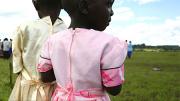Statistics and journal articles do not begin to convey the human toll of HIV. Lasker professor of health sciences Myron “Max” Essex has seen that toll firsthand, working in Botswana since 1996. As a relatively successful country with a functioning government and a well-organized healthcare system, Botswana has offered free antiretroviral medications to everyone who needs them and it has managed to get the majority of its citizens tested for HIV. Still, a staggering 24 percent of adults have HIV.
Essex first sought to conduct research in southern Africa because HIV was spreading much faster there than anywhere else in the world, including elsewhere in Africa. His lab in Gaborone now employs 225 people and has an annual budget of $13 million; the research conducted there has helped explain the higher transmission rates, how to treat patients without producing drug resistance, and how to block transmission from infected mothers to their infants.
Now, in Saturday Is for Funerals (Harvard University Press), Essex and Unity Dow, a judge in Botswana’s high court, describe how funerals subsumed that country’s social landscape, occupying every Saturday and sometimes weekdays as well. The book grew from a freshman seminar Essex teaches on AIDS in Africa: to help make biological topics more vivid for his students, Essex asked Dow—who specializes in human-rights law, with a particular focus on women and children, and whom he had consulted on ethical issues in his research trials—if she could contribute a personal story, from someone she’d met through her legal work, to illustrate the topic for each of the seminar’s 16 units. As the stories came together, the authors began to envision a wider audience.
And so, readers learn about the biology of transmission through the story of a marriage wrecked when a young wife learns she is HIV-positive. They learn about mother-to-child transmission through the story of a different young couple, a pregnant bride who learns too late that her husband is infected. The story of a girl who, despite rebellion and risky behavior, gets through her teenage years unscathed blends biology with cultural factors to teach about issues specific to young women. Through the lens of these stories, Essex and Dow introduce such complicated concepts as drug resistance, viral load, and opportunistic infections. Says Essex, “By pointing out the personal side of disease—human suffering and stigma and everything else—I hope we can use that as a hook to teach people about why the virus is as difficult to conquer as it is.”









